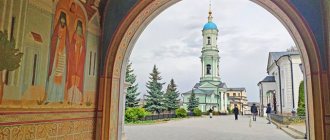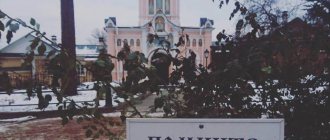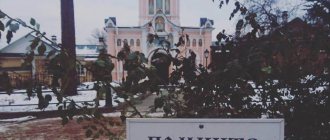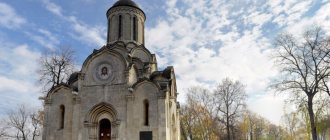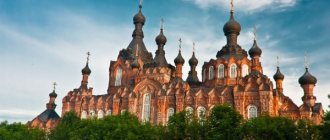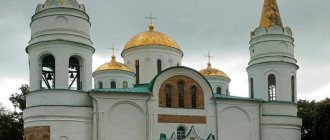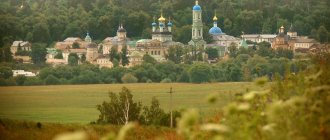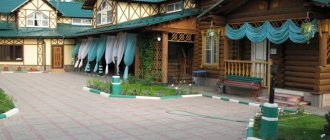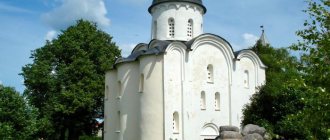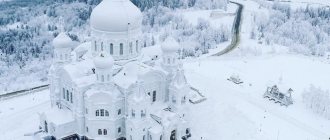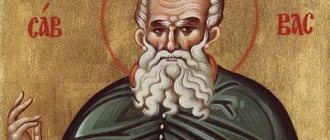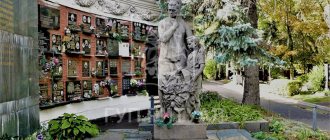Optina Pustyn is a stauropegic monastery of the Russian Orthodox Church, located near the city of Kozelsk, Kaluga region. Optina Pustyn is of great importance for the church life of Russia; its history is a living chronicle of the spiritual revival that arose at the end of the 18th century.
For reference: the stauropegic monastery does not depend on the local diocesan authorities and reports directly to the Patriarch.
The monastery is located next to a pine forest and separated from the world by the Zhizdra River, which contributed to the emergence of hermit life here. The elders who served on this land were distinguished by their prudence and insight, the gift of healing and miracles.
The monastery has a tour service located at the entrance to the monastery; the duration of the tours is 1–1.5 hours.
How to get there
The most convenient way to visit the monastery is during an excursion organized by the pilgrimage service of the Moscow or St. Petersburg metochion; you can also get to the monastery on your own:
- Take a bus from the Yugo-Zapadnaya metro station along the route Moscow - Kozelsk, the travel time will be 4-5 hours. The distance from the bus station in Kozelsk to the monastery is about three kilometers. Next, you can take a minibus or walk. To do this, you need to get on the highway leading to Sosensky, cross the bridge over the Zhizdra River, then walk along the grove until the first turn to the left, this road will lead to Optina Pustyn (from the turn you need to walk 1.5 km)
- By car, take the M3 highway to Kaluga, then follow to Kozelsk. Before reaching Kozelsk, turn left following the sign for Optina Pustyn.
Geographical location and place on the map
Optina Pustyn has the following GPRS coordinates: 54.053416, 35.831969.
Located in the Kaluga region. Pilgrimage trips from Moscow to the Holy Places of Russia. More details can be found in pilgrimage.
The distance from the regional center is 79 kilometers, from the capital of Russia - 256 kilometers, from St. Petersburg - 935 km. And the shortest distance from the nearest town called Kozelsk is only 2000 meters.
We are sure that you will be interested in the article about the Nikolo-Yamsky Church in Ryazan.
Story
According to legend, the monastery was founded at the end of the 14th century by a repentant robber named Opta (Optia), who took the name Macarius as a monk. Optina Pustyn served as a refuge for elders and elders who lived here in two different sections, under the control of one spiritual father.
The first stage of the monastery’s existence was marked by a difficult situation: it suffered during the Time of Troubles in the 16th century, and from 1704, during the reign of Peter the Great, the monastery paid a huge quitrent, which was used for the construction of St. Petersburg and the war with the Swedes.
The plight of the monastery is evidenced by the fact that it was forced to turn to previous investors for help. From 1724 to 1726, Optina Pustyn was abolished and annexed to the Belevsky Monastery in the Tula region. In 1764, during the secularization reform, the monastery was one of the unemployed monasteries of the Krutitsa diocese.
All these years there were only a few servants in the monastery; for example, in 1773 there were two of them. This continued until the end of the 18th century, when Metropolitan Platon of Moscow and Kaluga visited this amazingly beautiful place and appointed the experienced elder of the Pesnoshensky Monastery, Hieromonk Abraham, as rector. From that time on, the revival of the monastery began.
Optina elders
The elders present us with a living chronicle of the monastery. In 1996, the venerable elders of the desert were canonized as local saints. The most famous for contemporaries is Saint Ambrose, who led the desert for more than 30 years.
Hundreds of writings have been preserved about the miracles of preaching and healing by Hieroschemamonk. Bringing to the world love for God, veneration, respect and the need for unwavering prayer, he expanded and ennobled the monastery. He inherited the gift of eldership from Leonid and Macarius. During his reign, the Shamordino women's parish appeared in the monastery. And his writings and letters spread Christian wisdom throughout the Russian land.
IMPORTANT! The first elder was Leo - firm and determined, he devoted his life to serving the Lord and his neighbors. His faith and tireless prayer granted him miracles of healing and helping the suffering and disadvantaged.
Elder Macarius cultivated humility in people. He began publishing books by local elders and reprinting Russian monks.
Moses recorded his name as the main benefactor of the monastery. During his time, the desert became a home not only for pilgrims, but for all wanderers. He actively restored old churches and built new cathedrals. His brother Abbot Anthony led the work of the monastery for 14 years. He taught young monks and elders piety, asceticism and mercy.
Father Macarius was remembered by his contemporaries for his desire to convert lost souls to faith. He read sermons, talked with every parishioner and tried to find a way for them to God.
Father Euthymius gave wonderful disciples to the desert and preached the way to God through obedience and round-the-clock prayer in solitude.
God endowed Father Anatoly with the gift of consolation. The scripture says that since no one could pray to him, the power of his appeals to God was many times greater than anything today.
Saints Issaki, Joseph and Barsanuphius led the monastery during the difficult time of schism and rejection of religion (1810-1913).
Anatoly consoled parishioners and those who became residents of the sawmill during Soviet times. During these years, pilgrims and elders did not stop coming to the monastery. Nektarios spoke about the importance of humility, which granted healing and miracles to all who asked. Nikon and Isaac II suffered the most persecution from the atheists.
The symbol of Optina Pustyn today is Elder Iliy, one of the most mysterious representatives of the Russian clergy. Father Eli is famous for his God-given gift of building churches. Under his leadership, cathedrals are being built without interruption from ongoing work. The companion went through difficult years of abandoning his faith, spent ten years in Athos and never lost confidence in God’s providence.
Spiritual center of Russia
In 1797, the brethren of the monastery reached 12 people, and soon its staff increased to 30 inhabitants.
The construction of the monastery with stone buildings begins: a bell tower with two outbuildings for fraternal cells is being erected, the Kazan Church and a hospital church with cells are being built. Donations are used to purchase land and a mill.
In 1821, a monastery was built in the monastery, to which the suffering began to arrive. Optina Pustyn becomes the spiritual center of Russia.
In June 1878, Fyodor Dostoevsky stayed in Optina Desert after the death of his three-year-old son Alyosha. This trip became one of the most important events in the writer’s spiritual life.
With the advent of Soviet power, the monastery was closed, but for some time it existed under the guise of an “agricultural artel.” When it was closed, the Optina Pustyn Museum was organized here.
In the early 30s of the 20th century, a holiday home named after Maxim Gorky was opened on the territory of the former monastery.
During the Great Patriotic War, a hospital was located in Optina Pustyn, and later a filtration camp for military personnel returning from captivity.
In 1987, the monastery was returned to the Russian Orthodox Church, the first divine liturgy was held on June 3, 1988, on the day of the Vladimir Icon of the Mother of God.
Nutrition
Better stock up on provisions in advance. In the monastery, of course, you will be fed if you come with a registered pilgrimage group. But the monastic food is not to the taste of many - lean cabbage soup, pea or millet porridge and a quarter of a tomato or cucumber. Those unaccustomed to a lean diet will find this lunch unsatisfying.
By the way, dinner at the monastery is quite late at 21.30, but you can usually get to the refectory through the line by 22.30. But they won’t be particularly happy with dinner—again, it’s just porridge. It’s better to immediately go to the Tea Room on the territory of the monastery, they sell food at an affordable price - everything is 50 rubles, the menu includes salads, side dishes and meat dishes.
- If you are traveling on your own, upon entering the monastery territory you may be asked to give your backpack/bag to a storage room (keep your wallet and documents with you). It is better to immediately come to the desert with only the necessary things.
- If you have nowhere to stay, you may be allowed to spend the night in the temple, which will be closed from the outside. In this case, take an air mattress or sleeping bag with you, the floor is cold!
- The monastery is open to visitors from 5 am to 11 pm.
- Some areas of the monastery can only be accessed during services.
- Clothes for women: long skirt, covered shoulders, headscarf required. For men: trousers and long sleeve shirt.
- Confession is held in the Vladimir Church from 6.00 to 9.00
- Baptism takes place on Saturday for children at 13.30, for adults on Sunday at the same time. Before holding the sacrament, be sure to arrive at the meeting on Friday at 18.00.
Booking.com
Kazan Church
The temple in honor of the Kazan Icon of the Mother of God is the largest temple built in 1811, its thrones:
- Central - Kazan Icon of the Mother of God
- Northern - St. Great Martyrs George the Victorious and Theodore Stratilates
- Southern - Kresto-Vozdvizhensky.
Here are St. relics of the venerable Optina elders Moses, Anthony and Isaac I.
The Kazan Church holds daily evening services, and late liturgies on Sundays and holidays.
Holidays of the Optina Pustyn Monastery
Holidays in honor of the saints of Optina and the thrones are celebrated every month, attracting many guests:
| date | Holiday Event | |
| 8.01 | St. Martyr Isaac II | |
| 7.02 | St. Elder Anatoly (senior) | |
| Great Lent (II Sunday) | patronal feast of the Assumption Church | |
| 14.04 | St. elders | Varsanuphia |
| 12.05 | Nectaria | |
| 22.05 | Joseph | |
| 19.06 | Venerable Confessor Raphael | |
| 29.06 | St. Elder Moses | |
| 8.07 | Venerable Confessor Nikon | |
| 10.07 | St. Elder Ambrose (discovery of relics) | |
| 23.07 | St. Anthony (Pechersk, Kyiv) | |
| 12.08 | St. Elder Anatoly (younger) | |
| 20.08 | St. Elder Anthony | |
| 28.08 | Dormition of the Blessed Virgin Mary, | |
| 4.09 | St. elders | Isaac I |
| 20.09 | Makaria (Ivanova) | |
| 1.10 | Hilarion | |
| 23.10 | Ambrose | |
| 24.10 | all Optina elders | |
| 28.10 | Icons "Different of Loaves" | |
| 22.11 | Icons "Quick to Hear" | |
| 28.11 | St. Paisiy Velichkovsky | |
| 4.12 | Presentation of the Blessed Virgin Mary into the Temple | |
Believer or unchurched, coming to the Optina Hermitage physically feels the fertile atmosphere of the place of prayer. Confessions, conversations with monastics, and their sympathetic attention for a long time instill in the soul lightness, tolerance, and reconciliation with oneself and others.
Article design: Oleg Lozinsky
Church of Mary of Egypt
Temple in honor of St. Hilarion the Great was built in 1874; it is located outside the walls of the monastery, in the same building as the hotel and the pilgrimage refectory; baptisms and funeral services for the dead are performed there.
Also in Optina Hermitage there are the following temples:
- Temple in honor of St. John the Baptist and the Baptist of the Lord in St. John the Baptist Skete. Pilgrims are allowed to attend services only on patronal feast days of the monastery.
- The temple in honor of the icon of the Mother of God “Spreader of the Loaves” is located on the territory of the monastery’s subsidiary farm
- Temple in honor of St. Lev of Katansky and St. John of Rylsky with a temple in honor of the Archangel Michael is located in the lower semi-basement on the territory of the St. John the Baptist monastery
- The Church in honor of All Saints is located on the former monastery cemetery outside the monastery fence
- The temple in honor of the Transfiguration of the Lord was founded in 2005 by His Holiness Patriarch Alexy II.
What you must visit and see
The relics of Fr. Ambrose and Fr. Nectaria
Unfortunately, due to the tragic history of the monastery, there are almost no old buildings left on its territory. Everything had to be rebuilt, practically from ruins. And yet there are many important shrines here, which will be useful and interesting to look at even for a non-believer.
The monks of the monastery did a lot to restore spirituality to this holy place. This is felt by any person, regardless of faith, who finds himself here.
So what is worth visiting:
- Arriving at the monastery, you must definitely attend the service in the main Vvedensky Cathedral. Services are especially solemn during church holidays, as well as on the Days of Remembrance of the Great Optina Elders. In the temple you can venerate the relics of Fr. Ambrose and Fr. Nectaria, pray, just stand or light a candle at the miraculous icon of the Kazan Mother of God, which is located to the right of the altar;
Keep in mind: the territory of the monastery is closed to visitors, but to walk along the road along which the elders went to pray means to some extent to penetrate their world.
Vladimir Church
- Behind the Vvedensky Cathedral is the Vladimir Church with a small blue dome with stars. Here are the relics of the six great elders of Optina;
- The holy monastery springs are famous for numerous healings and miracles. Optina's three springs are no exception:
- One of them, the most famous, is located on the territory of the monastery, in honor of Paphnutius of Borovsk the Wonderworker;
- Source in honor of Fr. Ambrose is located not far from the monastery;
- The third source in honor of Sergius of Radonezh is hydrogen sulfide. It was recently rediscovered by monks. There is a bath here, immersion in the waters of which gives an extraordinary surge of strength.
It is worth not only drinking holy water from any source, but also taking it home. Holy water will last a long time. It should be drunk in the morning, after reading a special prayer before taking holy water, or in case of illness of family members. But everything must be done in faith. And it’s probably impossible to count how many people gained faith thanks to visiting Optina Pustyn...
St. John the Baptist Monastery
St. John the Baptist monastery in Optina Hermitage is located behind the monastery grove. When it was built, it was forbidden to cut down the forest so that the monastery would be closed from the eyes of people. The houses where writers Nikolai Gogol and Fyodor Dostoevsky stayed have been preserved here.
One of the oldest buildings of the monastery is the wooden Church of John the Baptist from 1822, built from the forest that grew on the site of the monastery.
It hosts round-the-clock services according to a special skete charter; pilgrims are allowed to these services only on the patronal feast days of the skete.
Also on the territory of the monastery there is a temple in honor of St. Lev of Katansky and St. John of Rylsky with a temple in honor of Archangel Michael in the lower semi-basement room, where water-blessing prayers are held for pilgrims living on the territory of the monastery. There is a hotel for pilgrims in the temple building.
Optina Pustyn is open to everyone who wants to visit its main churches - Vvedensky, Kazan and Vladimir, where free entry and access to the shrines of the monastery are blessed.
Optina Monastery for tourists. Excursions
In excursions to significant, memorable corners of Optina, the beauty of nature and human creations, the prayer and labor sides of the monastery are revealed, and its complex and dangerous historical path is learned. The monastery is visited daily by hundreds of people without time restrictions. But tourists are better off making a reservation in advance through the excursion service, which is open from 8.30 to 17.00 seven days a week.
At the agreed time, a full-time Optina guide and one of the brethren will take you through the temples, burial places of the venerable elders, murdered brothers, and new martyrs. There will be an interesting story about the main historical events, about famous figures, writers, artists who found food for the soul and creativity in the monastery.
It’s worth coming to Optina for 2-3 days to explore the women’s hermitages along a special route - Kazan St. Ambrose in the village of Shamordino, the Savior Not Made by Hands in the village of Klykovo. You definitely need to go to the healing springs, if not take a dip, at least wash, drink, and take holy water with you. Typically excursions last 1–1.5 hours.
Since tourism is one of the important items in the monastery’s budget, the amount of donations has been established:
- from adults – 150–200 rubles;
- for children – 50 rubles;
- for individual excursions or for a group of up to 10 people – 2000 rubles.
In the Optina Hermitage there is a shop where you can buy Orthodox literature, icons, video products, paintings, and souvenirs as souvenirs.
